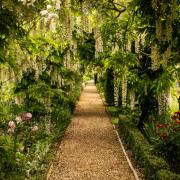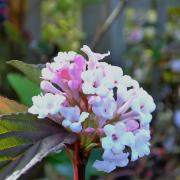Plant expert Keith Clouting of Taverham Nursery Centre with his May advice
Question time
I live on a corner plot and am looking to plant an intruder proof hedge to prevent people cutting across my garden; what would be the best plants for this?
There are several options for this if you’re looking to grow a native hedge then Prunus spinosa (blackthorn) or Crataegus monogyna (hawthorn) both make good barriers and are beneficial to wildlife, Ilex aquifolium (Holly) is a good evergreen option and will perform well in sun or shade. A non-native which makes a good impenetrable hedge is berberis, with evergreen and deciduous varieties available which will grow from as low as 45cm up to several metres when mature; they give you a good selection of heights to choose from.
Fabulous Fairy Bells
Disporum, commonly known as fairy bells, are outstanding spring flowering perennials for a shaded or semi-shaded border. They are a genus of around 20 species originating from Asia which are rightly becoming increasingly popular.
One of the showiest is Disporum uniflorum (syn. Flavens). This woodland gem emerges much like a Solomon’s seal with its flowers already showing at the tip of the stalk. It quickly unfurls revealing its full glory in a few days.

Later in the year the flowers are followed by black berries. It is hardy and easy to grow, forming a clump of around 60cm in time. A larger evergreen species is Disporum longistylum ‘Green Giant’ which was discovered in Sichuan province, China.
When established it has tall upright stems up to 1.5m which bear creamy-green to white hanging bell-shaped flowers in spring. These are followed by black-blue berries which persist through the winter.
Although it’s evergreen I like to cut back the older, untidy stems in spring to allow the new unfurling growth to look its best. A
n exciting new variety is Disporum cantonense ‘Moonlight’ which originated from a naturally-occurring mutation from D.c.’ Aureovariegata’. It has radiating silver-white and green variegation with the same bell-shaped flowers; it makes a much smaller plant growing to around 45-60cm when fully grown and with its variegation makes an excellent choice to brighten up a dark corner. Disporum grow well in shade or partial shade in fertile moist but well drained soil.
Plant of the month

Myosotidium Hortensia
This delightful evergreen perennial from the Chatham Islands, east of New Zealand, is almost extinct in the wild where it grows on sandy and rocky stretches of coastline. It has thick, fleshy stems and fabulous luxuriant glossy leaves to around 60cm. In the late spring and early summer, it produces clusters of bright forget-me-not like flowers which rise above the foliage. Myosotidium will tolerate some frost but benefit from protection. Grow in a sheltered spot with some shade in moist but well-drained soil; it can be a slightly tricky plant to grow but very rewarding.
Hint and tips
Regularly water recently put-in plants to help them establish well.
Gradually harden off bedding plants before planting out and keep some fleece handy in case of late frosts.
If early flowering clematis such as C.montana and C. alpine need tidying trim or cut back as soon as flowering has finished.
Tender fruit and veg such as sweetcorn, tomato, runner and low beans can be planted out at the end of the month after acclimatising, but watch the weather - being a little late is always better than too early.
If you need a break from lawn cutting join No Mow May a campaign by charity plant life to encourage us to let grassy areas grow for a few weeks and allow wildflowers to bloom and provide food for bees and other pollinators.




























